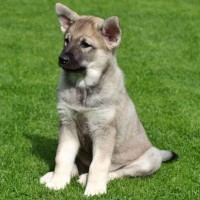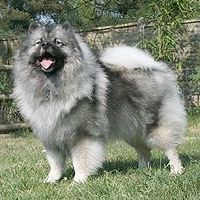Appearance of the Elk-Kee
|
| Elk-Kee dogs are medium-sized dogs that are a cross between a German Spitz / Keeshond and a gray Norwegian Elkhound. Common colors are likely to be black, silver, gray or cream, while their coat is likely to be short, thick and smooth. The Gray Norwegian Elkhound has dark brown, oval-shaped eyes and ears set high on the head, while the German Spitz / Keeshond is known for its unique facial markings that appear to form spectacles, with a dark line running from the outer corner of each eye towards the ear. Their eyes are dark brown, almond-shaped with black rims, while their ears are small, dark, triangular and erect. Both parent breeds have tails that curl over the back, so the Elk-Kee is also likely to do so. |
Temperament of the Elk-Kee
|
| Elk-Kees are likely to make excellent pets and are very good with children, like both parent breeds. They will be intelligent dogs, but will need solid training to ensure they recognize you as the leader of the pack. German Spitz / Keeshond are independent and make good watchdogs but love to be part of the family and its activities, a bit like the Norwegian Grey Elkhound who doesn't like to be left out. They are very loyal and can be quite possessive of their family. German Spitz / Keeshond will probably be a little easier to train than a Grey Norwegian Elkhound, so it will depend on which parent breed the Elk-Kee takes most to know how easy it will be to train, but as with all breeds, patience and positive reinforcement are the best paths to take. Both parent breeds will need to be stimulated physically and mentally, as they are energetic dogs. The Gray Norwegian Elkhound is friendly to strangers but can be aggressive towards other dogs. Early socialization is therefore important, while the German Spitz / Keeshond is somewhat wary of strangers but gets along with other dogs. |
Needs and activities of the Elk-Kee
|
| The Elk-Kee is likely to need regular exercise to keep fit, happy as both parent breeds are energetic dogs. Gray Norwegian Elkhounds particularly like fairly intense activity. They can exercise for about an hour a day while walking or playing, but will also love to run. They should be kept on a leash as they tend to wander and may take off after an interesting scent. A German Spitz / Keeshond also needs daily exercise and will enjoy a walk or a run. They also enjoy water, so a trip to the beach will be an option. They have been known to run in circles when feeling energetic, usually a sign that it's time to play or go for a walk. Both parent breeds tend to tolerate cold more than heat. The ideal home would be one with an enclosed yard, but Elk-Kees would do well in an apartment provided they get daily exercise. |
Maintenance of the Elk-Kee
|
| An Elk-Kee will need regular grooming to keep it looking good, which will include brushing about three times a week. Both parent breeds shed quite frequently, so the Elk-Kee is also likely to do so. The coats of both parent breeds tend to be naturally clean and they have no doggy odor, so you don't need to bathe him often. Neither parent breed is hypoallergenic, so an Elk-Kee is unlikely to be either. Try to brush your dog's teeth two or three times a week to avoid dental problems. Check the ears regularly and wipe them with a damp absorbent cotton pad. Check the nails regularly and trim them if they are too long. |









 English (United Kingdom)
English (United Kingdom)